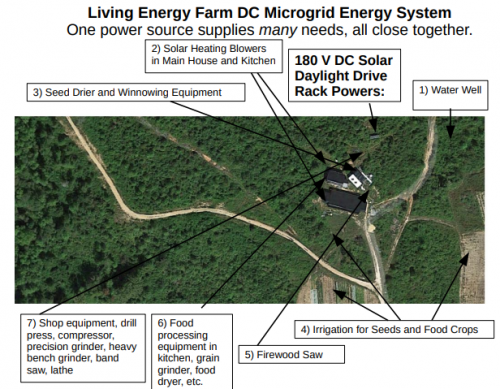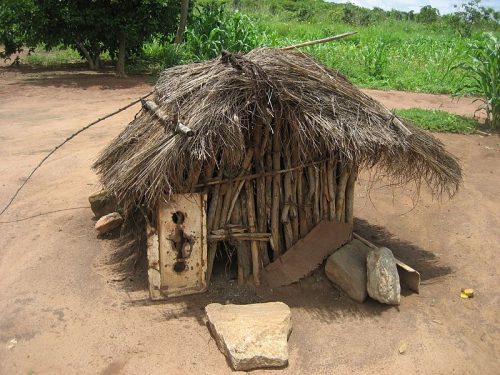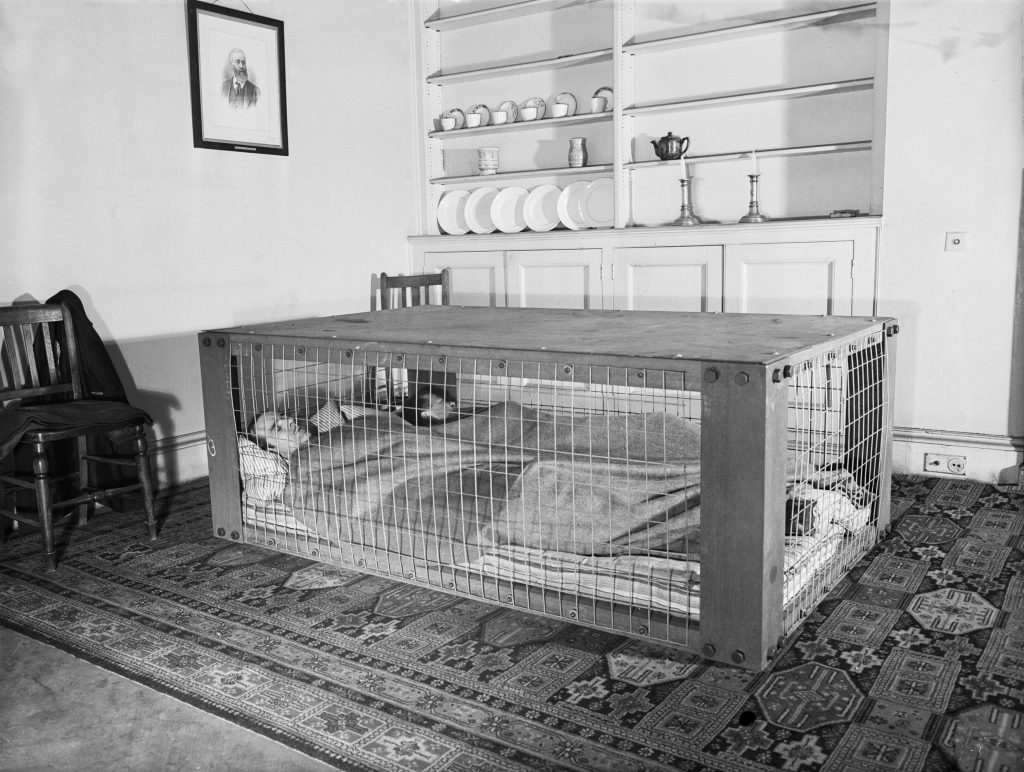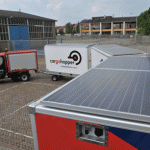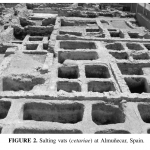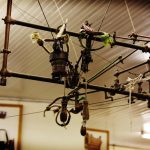Reader Goran Christiansson sends us a link to Living Energy Farm, a research and community project in Virginia, USA. Most notable is their use of “Daylight Drive” DC solar power without batteries for workshop tools — reminiscent of the ideas outlined in How to run the economy on the weather. Also of note is their choice for less efficient but more durable Nickel Iron batteries for lighting. [Read more…]
“Daylight Drive” DC Solar Power at the Living Energy Farm
“Diseconomies of Scale”: High-tech Versus Low-tech Supply of Eggs
Summarized from [paywall]: Trainer, T., A. Malik, and M. Lenzen. “A Comparison Between the Monetary, Resource and Energy Costs of the Conventional Industrial Supply Path and the “Simpler Way” Path for the Supply of Eggs.” Biophysical Economics and Resource Quality 4.3 (2019): 9.
Traditional housing for chickens in Zembe, Mozambique. By Ton Rulkens – Traditional housing 2, CC BY-SA 2.0.
Global sustainability requires large-scale reductions in rich world per capita resource use rates. Globalised, industrialised and commercialised supply paths involve high resource, energy, dollar and other costs. However, “The Simpler Way” involving small-scale integrated localised settlements and economies can enable enormous reductions in these costs. This study uses input–output analysis of one product, eggs, to illustrate how big the difference between the two paths can be. [Read more…]
The Morrison Shelter
In the UK during World War Two, due to the lack of house cellars it was necessary to develop an effective type of indoor shelter. The Morrison shelter, officially termed Table (Morrison) Indoor Shelter, had a cage-like construction beneath it, and was designed to be able to withstand the upper floor falling, of a typical two story-house undergoing a partial collapse. [Read more…]
Evaporative Air Conditioning
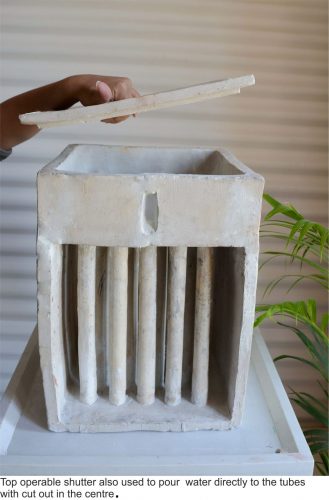 Evaporative coolers have been known to purveyors of low-cost, sustainable technologies for years. Without the need for electricity, these cold containers have kept produce fresh from farms to tables, protecting against post-harvest losses in the field and food spoilage in hot pantries worldwide.
Evaporative coolers have been known to purveyors of low-cost, sustainable technologies for years. Without the need for electricity, these cold containers have kept produce fresh from farms to tables, protecting against post-harvest losses in the field and food spoilage in hot pantries worldwide.
Now the concept has been applied to air conditioning. Manoj Patel Design Studio in Vadodara, Gujarat (India) has built evaporative air conditioners that can cool a room for days on a single tank of water. The studio designs new products from recycled materials, and they built their air conditioners from ceramics and stone, integrating them with potted plants. By filling rows of ceramic tubes with water, the prototypes maximize their surface area for optimal evaporation while retaining a small footprint.
Read more: This Air Conditioner for Homes and Offices Uses No Electricity, Engineering for Change. Previously: How to keep beverages cool outside the refrigerator: the botijo.
Sustainability Gains from Meat Alternatives
“Meat, an important source of protein and other nutrients in human diets, is one of the major drivers of global environmental change in terms of greenhouse gas emissions, land and water use, animal welfare, human health and directions of breeding. Novel alternatives, including novel meat proxies (cultured meat, plant-based meat alternatives), insects and novel protein sources (like algae) receive increasing attention. But plausible socio-technological pathways for their further development have not yet been compared in an integrative, interdisciplinary perspective.”
“High levels of transformation and processing limit the environmental sustainability gains of cultured meat, highly processed plant-based meat alternatives, algae- and insect-based food. At the same time, a high degree of societal coordination is needed to enable the potentially disruptive level of technological, organisational and institutional innovations needed to make these novel alternatives viable. Widespread expectations that solutions require break-through novelties or high-tech alternatives imply a neglect of existing and viable alternatives.”
“Our integrative analysis suggests that the priority given to meat alternatives with limited sustainability potential does not just raise questions of technological optimisation of production systems, but is also a second-order problem of the framing of search directions.”
Read more: Meat alternatives; an integrative comparison, Cor van de Weele et al., Trends in Food Science and Technology, April 2019. Image: Presentation of the world’s first cultured hamburger being baked at a news conference in London on 5 August 2013. World Economic Forum (CC BY 3.0)
Another Day, Another Low-tech Website
French designer and researcher Gauthier Roussilhe was inspired by our solar powered website and built a low-tech website himself, documenting the process in detail (and in English). It’s a great work, and there’s some interesting differences with our solar powered blog.
First, Roussilhe built his site with a user friendly content management system (Kirby), which is then converted into a static website. Compared to our approach, this makes it easier to build a light-weight website for those who are accustomed to working with WordPress.
Second, the designer also tackles his videos, which are hosted on Vimeo and Youtube, and manages to reduce their “weight” by 75%. This is a major contribution, because video takes up the largest share of internet traffic.
Here’s his own conclusion:
If we take stock: I reduced the weight of my site by 10, the average weight of a page by more than 3 and I reduced the weight of my videos on third-party services by 4. I have a site extremely simple to administrate, very light so very fast, which consumes very little electricity and therefore emits little GHG.
The site also follows all the canons of today’s digital design: mobile-first, accessibility, loading speed. In fact it is quite surprising to realize that structural limitations (weight / energy) lead to navigation experiences much more accessible to all audiences regardless of their equipment, their connection or their imperative motricity or vision.
Read more: Digital guide to low tech.
